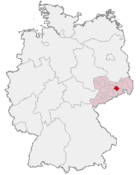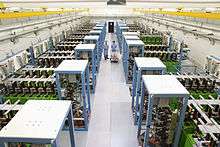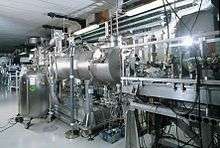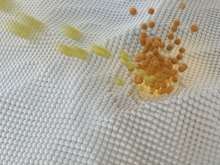Helmholtz-Zentrum Dresden-Rossendorf
The Helmholtz-Zentrum Dresden-Rossendorf (HZDR) is a Dresden-based research laboratory. It conducts research in three of the Helmholtz Association's areas: materials, health, and energy. HZDR is a member of the Helmholtz Association of German Research Centres.
 | ||
|---|---|---|
Entrance of the HZDR |
 | |
| established: | 1992 | |
| Scientific director: | Sebastian M. Schmidt | |
| Administrative director: | Ulrich Breuer | |
| staff: | 1.200 (2018) | |
| budget: | ca. 132 Mio. Euro (2018) | |
| location: | Dresden, Germany | |
| official website: | www.hzdr.de | |
History
After the German reunification the "Forschungszentrum Rossendorf" (FZR) was founded. The center was founded in 1956. The former research center in Rossendorf was part of the German Academy of Sciences. The German-born British physicist Klaus Fuchs, who took part in the Manhattan Project and acted as a spy for the Soviet Union, was deputy director until 1974.
In 1992 it became known as Forschungszentrum Dresden-Rossendorf. In 2006 the name changed to "Forschungszentrum Dresden-Rossendorf", to emphasize the connection to the research infrastructure in the city of Dresden. In 2011 the center became a member of the Helmholtz Association of German Research Centres.[1]
Research programs



HZDR conducts research in the materials, health and energy sectors in Dresden and at three other locations in Germany and France. In Grenoble, it operates a beamline for materials and radiochemistry research at the European Synchrotron Radiation Facility (ESRF). Three of HZDR's five large-scale facilities are available to international scientists.
Materials
HZDR scientists are investigating the structure and function of new materials in order to better understand, optimize, and use them for specific applications. This includes research on novel superconducting and semiconducting materials using high magnetic fields or ion beams. They are developing detectors for applications in medicine and technology, and are advancing technologies for particle acceleration.
Health
HZDR aims at making progress in early diagnosis and therapy of cancer. It collaborates with partners from university medicine (National Center for Radiation Research in Oncology, OncoRay, in Dresden). HZDR cancer research concentrates on three major fields: new radioactive pharmaceuticals for cancer diagnosis and therapy, innovative medical imaging methods used in oncology as well as particle acceleration using new laser technologies for radiation oncology.
Energy
HZDR researchers are looking for economically and ecologically feasible energy solutions. The Helmholtz Institute Freiberg for Resource Technology, a joint initiative of HZDR and TU Bergakademie Freiberg, is targeting new technologies for the exploration, mining, and use of strategically important metals and minerals, e.g. biotechnological methods for metal recycling. Scientists also study energy-intensive processes in industry, like steel casting or in the chemical industry. They are examining nuclear repositories and reactors. And they are contributing to new storage technologies, e,g., developing a liquid metal battery.
Research facilities
HZDR operates multiple research facilities.
- ELBE is a Center for High-Power Radiation Sources and HZDR's largest research facility. It encompasses a superconducting Electron Linear accelerator for beams with high Brilliance and low Emittance (ELBE) and two FEL for the mid and far infrared spectra. In addition, the electron beam delivers multiple other secondary beams (quasi-monochromatic X-rays, polarized Bremsstrahlung, pulsed neutron beams and pulsed mono-energetic positrons).[2]
- The 150 TW laser system Dresden Laser Acceleration Source (DRACO)[3] is part of HZDR's ELBE Center for High-Power Radiation Sources.
- The Dresden High Magnetic Field Laboratory targets an ambitious goal to provide 100 Tesla for materials research. It serves as a research facility for in-house and customer projects. The laboratory was erected in the vicinity of ELBE, which can accomplish magneto-optical experiments. Under the program EuroMagNETII/EMFL the EU funds the laboratory as an international user center.[4]
- HZDR operates an Ion Beam Center[5] for the application of ion beams in materials research. Plasma and ion sources generate ions of all species at energies between 10 eV and 50 MeV. The center is funded as a user facility by the EU.
- ROBL, the Rossendorf Beamline at the ESRF in Grenoble/ France, comprises two facilities for materials research and for radiochemical experiments.[6]
- The PET Center[7] is operated together with Technische Universität Dresden and University Hospital Dresden. Researchers are developing imaging methods for cancer diagnosis as well as new approaches to cancer treatment.
- The thermohydraulic test facility TOPFLOW investigates stationary and transient phenomena in two-phase flows and develops models derived from Computational Fluid Dynamic (CFD) Codes.[8]
- The DREsden Sodium facility for DYNamo and thermohydraulic studies (DRESDYN) is intended as a platform both for large scale experiments related to geo- and astrophysics as well as for experiments related to thermohydraulic and safety aspects of liquid metal batteries and liquid metal fast reactors. Its most ambitious projects are a homogeneous hydromagnetic dynamo driven solely by precession and a large Taylor-Couette type experiment for the combined investigation of the magnetorotational instability and the Tayler instability.[9]
Departments
- Institute of Ion-Beam Physics and Materials Research
- Dresden High Magnetic Field Laboratory
- Institute of Fluid Dynamics
- Institute of Radiation Physics
- Institute of Radiopharmaceutical Cancer Research
- Institute of Radiooncology
- Institute of Resource Ecology
- Helmholtz Institute Freiberg for Resource Technology - close collaboration with Technische Universität Bergakademie Freiberg
- Department of Research Technology
Collaborations
The HZDR is nationally and internationally connected to other institutions and organised in various research alliances.
International collaborations
- European Synchrotron Radiation Facility (ESFR)
- European XFEL
- Weizmann-Helmholtz Laboratory for Laser Matter Interaction (WHELMI)
- European Magnetic Field Laboratory (EMFL)
- League of European Accelerator-based Photon Sources (LEAPS initiative)
- European Association of National Research Facilitis (ERF)
- Extreme Light Infrastructure (ELI)
- EIT Raw Materials
- Innovative, Non-Invasive and Fully Acceptable Exploration Technologies (EU project INFACT)
- ions4SET
National collaborations
- DRESDEN-concept
- TU Dresden
- TU Bergakademie Freiberg
- TU Chemnitz
- German Working Group for Repositoy Research / Deutsche Arbeitsgemeinschaft Endlagerforschung
- Competence Pool for Radiation Research / Komptenzverbund Strahlenforschung
- Competence Pool East for Nuclear Technology / Kompetenzverbund Ost für Kerntechnik
Staff and research sites
The HZDR employs about 1,000 staff, working at four research sites. The headquarters is in Dresden.
Technology transfer
The HZDR Innovation GmbH[10] corporation offers industrial services using HZDR's know-how and infrastructures in ion implantation. This technology is applied for doping material surfaces with foreign atoms or to produce defects in semiconductors. It is also used to create materials with targeted features such as oxidation resistance, which is important for aviation or automotive lightweight construction, or biocompatibility for medical implants.
Students and young scientists
Roughly 160 doctoral students work there. The HZDR installed junior research groups to promote excellent young scientists, the topics of which as of 2013 were: ion beam processed functional materials for spintronics and photovoltaics, computational radiation physics, spintronics, reactor physics, magnetization dynamics and magnetostatic, tumor specific PET tracers, in-vivo dosimetry for new types of radiation (together with the Dresden-based National Center for Radiation Research in Oncology - OncoRay). HZDR operates an International Helmholtz Research School for Nanoelectronic Networks (NANONET)[11] as well as a Summer Student Program.[12]
Notes
- "Pressemitteilung vom 22. Juni 2009: Per Unterschrift besiegelt – das FZD wechselt zur Helmholtz-Gemeinschaft Deutscher Forschungszentren (german)". HZDR. 2009-05-22. Archived from the original on 2011-07-18. Retrieved 2009-05-22.
- "Radiation Source ELBE". HZDR.
- "DRACO". HZDR.
- "Dresden High Magnetic Field Laboratory". HZDR.
- "Ion Beam Center". HZDR.
- "Rossendorf Beamline at ESRF". HZDR.
- "PET Center". HZDR.
- "TOPFLOW - Transient Two Phase Flow Test Facility". HZDR.
- Stefani, F.; Eckert, S.; Gerbeth, G.; Giesecke, A.; Gundrum, Th.; Steglich, C.; Weier, T.; Wustmann, B. (2012). "DRESDYN - A new facility for MHD experiments with liquid sodium". Magnetohydrodynamics. 48: 103–113. arXiv:1201.5737. Bibcode:2012arXiv1201.5737S. doi:10.22364/mhd.48.1.12.
- "HZDR Innovation GmbH". HZDR Innovation GmbH.
- "NANONET". HZDR.
- "Summer Student Program". HZDR.